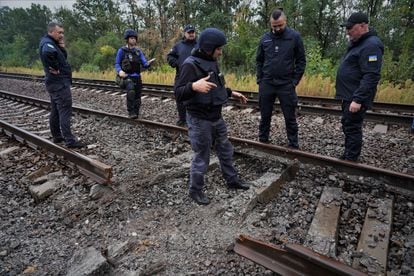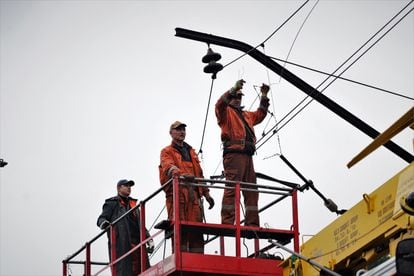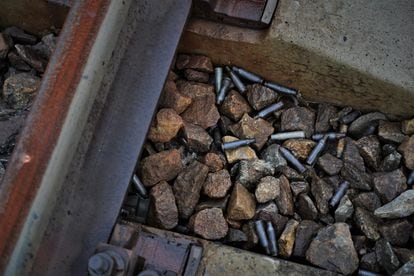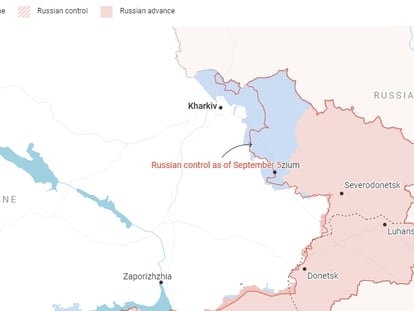Ukraine recaptures the eastern city of Balakliia
To restore infrastructure damaged by the Russian invasion, experts from Ukrainian Railways have entered the newly-liberated territory


Smoke floods the 44-mile-long railroad track that leads from Kharkiv to Balakliia, one of the cities that the Ukrainian army has just liberated from Russian occupation.
Remains of all kinds of ammunition appear on the pebbles and tracks, from missile casings to mortar shells. There are craters of different sizes, marking recent explosions. Every few miles, the tracks are torn apart, or the suspension cables have been downed. The bridge that crosses over the river has also been battered by attacks.
For more than six months, since the Russian invasion on February 24, this route hasn’t seen a single train pass by. The neglected rail infrastructure has been caught between scenes of intense combat, deprived of any sort of maintenance. Along the tracks, you can see damaged trees and destroyed farms.
Having regained ground in the midst of the Russian invasion, the authorities in Kyiv – the Ukrainian capital – want to restore normalcy as soon as possible.
“We’ll have this fixed in a few hours,” says Oleksander Kamyshin, the general director of Ukrainian Railways. The state-owned enterprise is the largest employer in the country, with more than 230,000 employees. It has been a constant target of attacks by Russian forces, who are aware that rail transport is essential for moving people and goods.

Accustomed to moving decisively throughout this conflict, Kamyshin wanted to be the first to inspect the damage firsthand. It is part of an expedition that, since Monday, has closely analyzed what needs to be repaired, so that rail service and communication lines can be restored as soon as possible. “Immediately,” emphasizes the head of the railway. But, he clarifies, the first thing is safety and, for this to be achieved, the demining work must be completed.
A train engine with a platform for repairing cables carries a dozen people, including the driver, two of Kamyshin’s bodyguards and this reporter. The journey is not without surprises. At one of the crossings, despite the fact that the operator from the control panel sounds the horn non-stop, an armored car loaded down with troops crosses just a few feet away, almost being struck by the train.

“We’re [trying] to restore the mobility of citizens as soon as possible, the distribution of humanitarian aid, cargo to boost the economy... in short, we’re trying to recover our rhythm of life,” explains Kamyshin. He is aware of the great counteroffensive that has been unleashed across eastern Ukraine. The area has been essential for the invading Russians to receive supplies from their country, only 30 miles away – they are desperate not to lose control. The head of the national railway recognizes that, beyond Balakliia, the cities of Kupiansk and Izium are still home to pockets of resistance… it is not on the agenda to restore train service to those areas at the moment.
Kamyshin is accompanied, among others, by two of his most trusted men, those responsible for infrastructure and passengers. They take their time moving along a path where the train moves very slowly. The rainy landscape is made up of empty fields and the occasional country houses. They stare, motionless, at stations that have stood at the foot of the tracks for more than a century.
On the outskirts of Balakliia, the expedition reaches a point where it cannot continue by rail until the necessary repairs are made. Kamyshin descends, drops to the ground and begins to walk forward with his group. Before they headed for this region, those in charge of security warned that, due to the danger of unexploded mines, no one should stray more than three feet from the tracks. The 38-year-old director jokes with the employees – who are equipped with bulletproof vests and helmets – and jogs away as if he is expecting an imminent explosion. Andrii Stepanect – one of the experts – stays behind and waits for the group to move away before he oversees the controlled detonation of a mine.

Kamyshin observes every detail. “Look at the rusty rails,” he sighs. “They’re like that because they haven’t been used for six months.” Later, he puts some bullets in his pocket as souvenirs. The director general of Ukrainian Railways has to be warned that it is dangerous for him to climb onto the moving platform.
During the journey, he holds meetings and impromptu talks on the future of the conflict or on how to speed up the opening of new rail routes. It is strange to accompany him on the ground just a few days after he received US Secretary of State Antony Blinken in Kiev. Blinken made the visit via the “iron diplomacy” program, which allows authorities from all over the world to travel by train into Ukraine, a country that has closed its airspace to civilian flights.
As night falls on the return to Kharkiv, the train becomes the scene of an impromptu picnic, with bread, sausage and tomato. Someone manages to nod off in the middle of the rattling journey – Kamyshin pulls out his cellphone and captures the moment with a mischievous smile.

/cloudfront-eu-central-1.images.arcpublishing.com/prisa/Q4XOUR4CWOWYPW6EZ4VQOFUCUY.jpg)










































